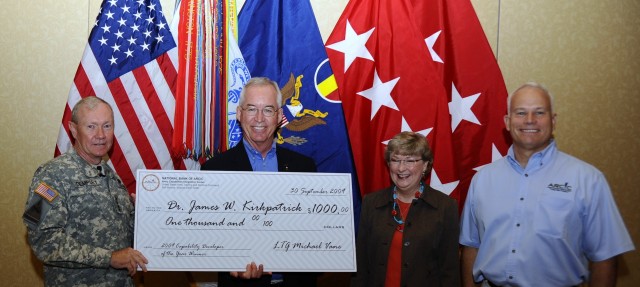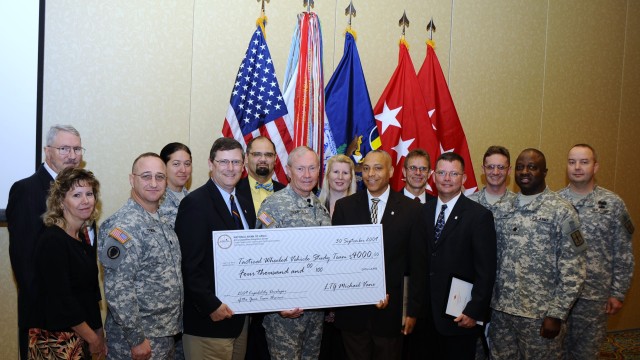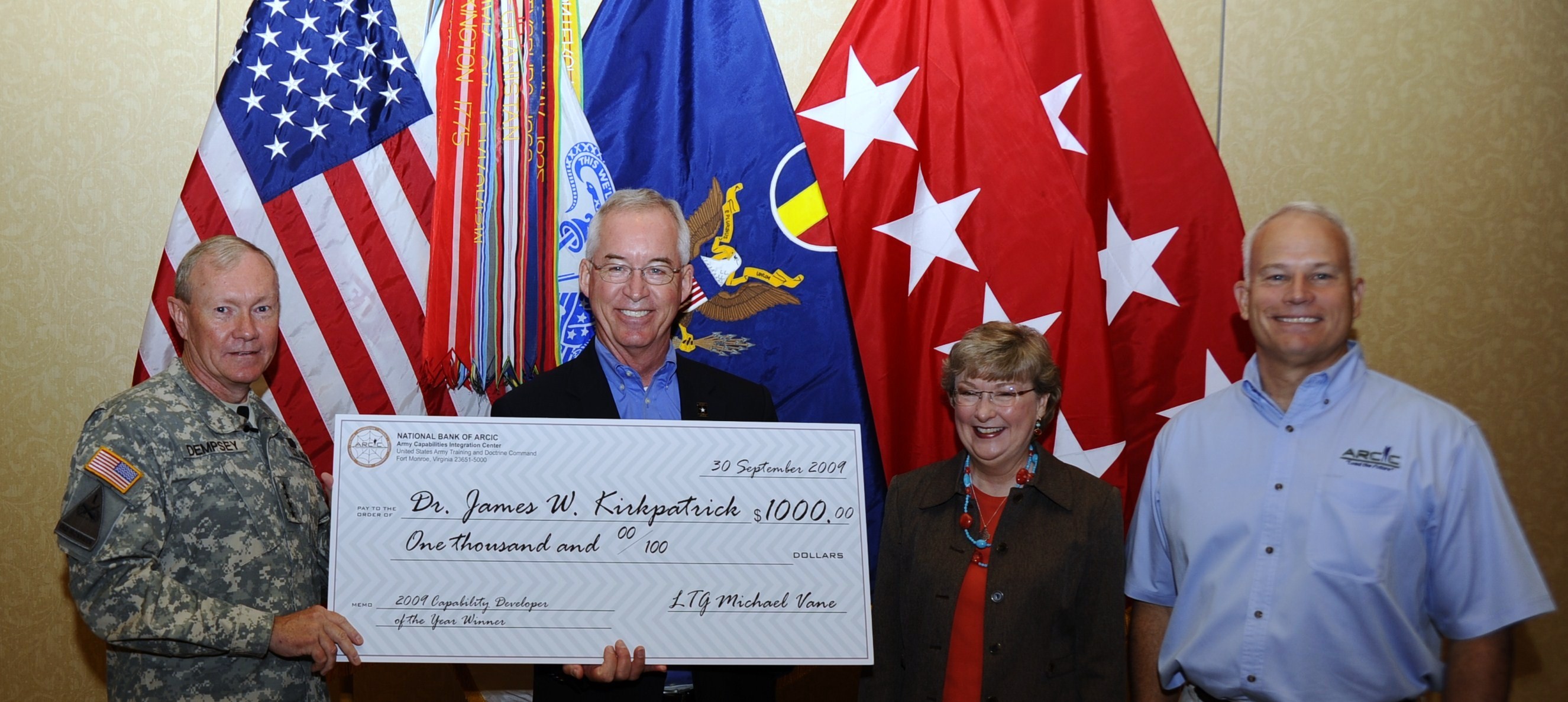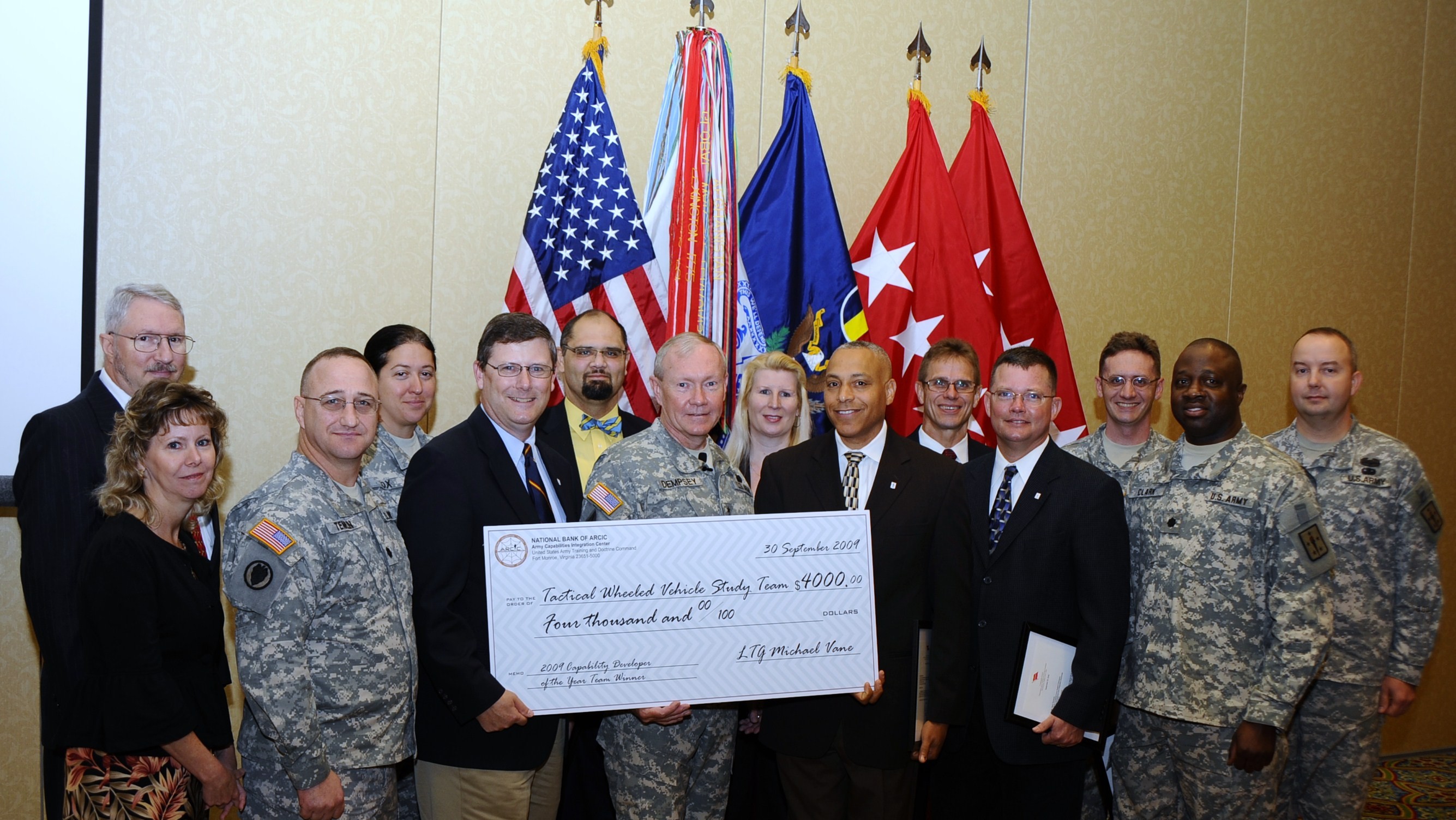FORT MONROE, Va. (Oct. 2, 2009) - The second annual Individual Capability Developer and Team Developer Awards were presented to the winning individual and team today at the Army Capabilities Integration Center Capability Integration Enterprise Conference here.
The Capability Developer of the Year award was presented to Dr. James Kirkpatrick, senior clinical consultant, Directorate of Combat and Doctrine Development, Army Medical Department Center and School. The Capability Developer Team of the Year was awarded to Jay Allen, Barry Richards, Lt. Col. Douglas Tuttle, Lt. Col. Jeff Templin, Brian Mathiesen, Mary Lane, Maj. Dawn Cox, Kevin Cale, Lt. Col. Herbert Clark, Ulrike Lane, Capt. Jared McCormick, Mario Griner, Maj. Troy Temple, and Thomas Pope of the Combined Arms Support Command (CASCOM) Tactical Wheeled Vehicle Study Team.
Gen. Martin Dempsey, commander of the U.S. Army Training and Doctrine Command, and Lt. Gen. Michael Vane, deputy commanding general for futures and director of the U.S. Army Training and Doctrine Command's Army Capabilities Integration Center (ARCIC), presented the second annual Individual Capability Developer and Team Developer Awards.
Vane implemented these awards to promote and recognize innovation, improvement, and maximized efficiency in capability development products. This program applies to the TRADOC and non-TRADOC concept and capability developments community of practice.
Concept and capability developers are responsible for identifying, assessing, and documenting changes in doctrine, organization, training, materiel, leadership and education, personnel and facilities that produce force capabilities and attributes prescribed in force concepts. Their role has increased in support of the current wars in Iraq and Afghanistan and in the development of the future force to combat global extremism in an environment of persistent conflict.
Nominees for the award demonstrated outstanding leadership, innovation, flexibility, and overall excellence in accomplishing their concept and capabilities development duties. This summer, senior leaders in the community of practice nominated several professionals for the award. Vane convened a review board comprised of several ARCIC senior leaders to consider and score the nominations, which Vane used to make the final selection.
Kirkpatrick won the Capability Developer of the Year award for his work in redesigning the Combat Support Hospital (CSH) and Hospital Augmentation teams and effecting significant improvements in the Army-wide Combat Lifesaver (CLS) program. Hospitalization, redefined by Kirkpatrick, reduces the number of elements of the hospital from 11 to six, while increasing its capability, versatility, agility and deployability. He redesigned Hospital Augmentation teams to leverage the generating force and to expand specific medical capabilities not resident within the CSH to best support full spectrum operations. The CLS program was developed and implemented to augment the skills of non-medical personnel, allowing them to provide lifesaving initial interventions until the arrival of a medic or other skilled provider. Kirkpatrick identified a change in the need for immediate IV interventions opting more for rapid attention to stopping the bleeding and quick evacuation. This led to the replacement of IV bags with warm blankets in the CLS program which offered numerous benefits.
The Tactical Wheeled Vehicle (TWV) Study Team works the Force Design Directorate, Combine Arms Support Command at Fort Lee, Va. They undertook a study to reduce unnecessary TWV while maintaining capability and capacity in the formations. The initial assumption was the Army had too many vehicles and could not modernize while continuing to sustain the existing fleets. The team revealed that by adding specific modernization initiatives, the Army could save 3,846 force structure spaces to help bring the Army back into balance. The study effort also showed that by reducing significant numbers of vehicles the Army G-8 would be able to remove vehicles that were at the end of their useful life cycle and cascade newer vehicles to displace aging fleets. The net effect of the TWV study, once fully implemented, will create a smaller, younger, more reliable and essentially less-expensive truck fleet.
During the event, Lt. Col. Jonny Grigorian, Daryll Robinson, Michael Lingenfelter, and Michael Byers, four members of Task Force 120, were recognized for their work on TRADOC tasks to develop components of the Army's modernization plan. Task Force 120 was charged with developing capability package requirements for the modernization of Army Brigade Combat Teams. The team finished their product and disbanded on Sept. 1.
Vane concluded the event saying, "I applaud everyone's efforts and I am looking forward to next year's competition."




Social Sharing